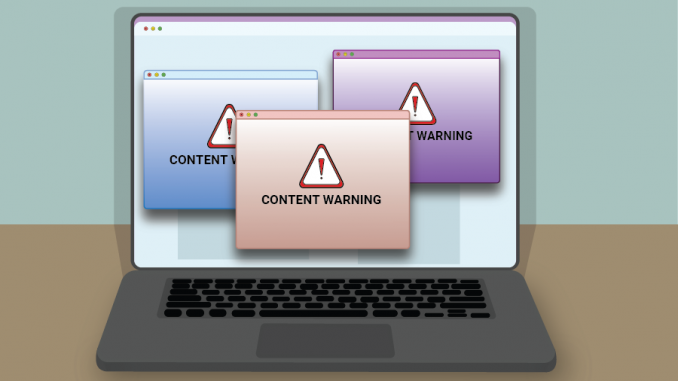
Classrooms should always be a safe space for students.
One way professors can ensure students feel comfortable in class is to include trigger warnings before teaching graphic material.
A “trigger warning” is defined as a statement used to warn audiences that content may be upsetting or disturbing, The New York Times reported.
In a 2016 survey conducted by NPR, 64.7 percent of college professors reported they use trigger warnings in the classroom, regardless of whether students requested them because they thought the material could be distressing and needed a forewarning. Most often, they are used before sexual or violent material, as well as racially, religiously or politically charged topics.
In educational settings, trigger warnings often include a statement that warns the student of graphic references relating to sexual abuse, self-harm or violence that may cause psychological trauma, especially for students diagnosed with anxiety or post-traumatic stress disorder, according to the University of Waterloo.
In classes where potentially traumatic topics like eating disorders or domestic violence may be discussed, like film, public health and psychology classes, professors should implement trigger warnings prior to the lesson, and other students should take trigger warnings into consideration when presenting material in class.
In Nicole Cavacloglou’s public speaking class this semester, the class took a 20-minute break after a student delivered a particularly graphic speech about child brides, they said. The student did not announce a trigger warning prior to giving the speech, said Cavacloglou, a sophomore communication and social influence major.
“Even if there isn’t a specific guideline to include a trigger or content warning, I think that if you know that your topic could be a harder topic to talk about, then I’d take it upon yourself to do a warning for the general class even if it’s not a requirement,” Cavacloglou added.
Rather than using trigger warnings specifically, Robert Jaffe, a film and media arts professor, introduces films as NC-17, a label that indicates the film is meant for audiences 17 years of age and older. He does not want to spoil the element of surprise in his films by giving away major plot points, but he does want students to know in advance if they involve violence or sexual assault, he said.
“I think it’s generally a good idea to offer trigger warnings, especially when you’re dealing with subjects in a classroom that are outside the norm of what you would normally deal with,” Jaffe said.
Trigger warnings can help students recovering from mental illnesses, self-harm and suicidal tendencies prepare to engage or disengage from content for their own wellbeing, according to the University of Michigan.
Critics argue trigger warnings exempt students from classwork, censor professors, discourage open debate and coddle students, according to Psychotherapy Networker.
But the idea that trigger warnings are designed solely to excuse students who don’t want to participate or to suppress professors is a misconception, said Adrienne Shaw, a media studies and production professor.
“The censorship would be, ‘I don’t assign things because I think it triggers trauma in the student,’” Shaw said. “Trigger warnings in the classroom and trigger warnings historically have been much more about making sure somebody knows before they stumble into something that’s what it’s going to be about.”
Temple University has no universal policies on trigger warnings, wrote Raymond Betzner, a spokesperson for the university, in an email to The Temple News.
“We do have regular workshops for faculty on trauma-informed pedagogies, pedagogies of care and managing difficult conversations and difficult topics in class,” Betzner wrote.
In Aug. 2020, the Center for the Advancement of Teaching partnered with the Wellness Resource Center, Office of Inclusion, Diversity, Equity, Advocacy and Leadership and Tuttleman Counseling Services to sponsor a three-part workshop on trauma-informed teaching.
The research surrounding the effectiveness of including trigger warnings is inconclusive, but they are part of a trauma-informed approach that gives people autonomy to choose their exposure to sensitive subjects, said Hillary Black, a licensed clinical social worker and assistant coordinator of sexual assault counseling and education at Tuttleman Counseling Services.
“When we’re talking about triggered in a therapeutic and mental health perspective, we’re really talking about folks who meet the criteria for PTSD, who are experiencing lots of hyperarousal due to their trauma, and there are very real triggers that can be anything from the mundane to the content that is very similar to the events that occurred to them,” Black said.
By adding trigger warnings before lessons, professors can promote an inclusive environment and demonstrate they care about their students’ mental and emotional well-being.
“‘Triggered’ might not be the most accurate word, but I think it’s helpful to have a common dialogue around, ‘Okay, how do I talk about my mental health? How do I talk about how I’m feeling aroused or upset?’ and it leads us to be able to have a conversation that, ‘How can I take care of myself when I’m distressed?’” Black said.



in most real world situations there are no “trigger warnings.” seems like we are taking a step backwards here with regards to our ability to confront and handle things that can be considered distressing.
God help us all if this is the state of higher education.
Such a great article. I would love to see trigger warnings become more common.